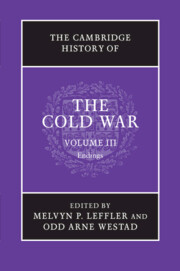Book contents
- Frontmatter
- 1 The Cold War and the intellectual history of the late twentieth century
- 2 The world economy and the Cold War, 1970–1990
- 3 The rise and fall of Eurocommunism
- 4 The Cold War and Jimmy Carter
- 5 Soviet foreign policy from détente to Gorbachev, 1975–1985
- 6 Islamism, the Iranian revolution, and the Soviet invasion of Afghanistan
- 7 The collapse of superpower détente, 1975–1980
- 8 Japan and the Cold War, 1960–1991
- 9 China and the Cold War after Mao
- 10 The Cold War in Central America, 1975–1991
- 11 The Cold War and southern Africa, 1976–1990
- 12 The Gorbachev revolution and the end of the Cold War
- 13 US foreign policy under Reagan and Bush
- 14 Western Europe and the end of the Cold War, 1979–1989
- 15 The East European revolutions of 1989
- 16 The unification of Germany, 1985–1991
- 17 The collapse of the Soviet Union, 1990–1991
- 18 Science, technology, and the Cold War
- 19 Transnational organizations and the Cold War
- 20 The biosphere and the Cold War
- 21 The Cold War and human rights
- 22 The Cold War in the longue durée: global migration, public health, and population control
- 23 Consumer capitalism and the end of the Cold War
- 24 An ‘incredibly swift transition’: reflections on the end of the Cold War
- 25 The restructuring of the international system after the Cold War
- Bibliographical essay
- Index
- References
2 - The world economy and the Cold War, 1970–1990
Published online by Cambridge University Press: 28 September 2010
- Frontmatter
- 1 The Cold War and the intellectual history of the late twentieth century
- 2 The world economy and the Cold War, 1970–1990
- 3 The rise and fall of Eurocommunism
- 4 The Cold War and Jimmy Carter
- 5 Soviet foreign policy from détente to Gorbachev, 1975–1985
- 6 Islamism, the Iranian revolution, and the Soviet invasion of Afghanistan
- 7 The collapse of superpower détente, 1975–1980
- 8 Japan and the Cold War, 1960–1991
- 9 China and the Cold War after Mao
- 10 The Cold War in Central America, 1975–1991
- 11 The Cold War and southern Africa, 1976–1990
- 12 The Gorbachev revolution and the end of the Cold War
- 13 US foreign policy under Reagan and Bush
- 14 Western Europe and the end of the Cold War, 1979–1989
- 15 The East European revolutions of 1989
- 16 The unification of Germany, 1985–1991
- 17 The collapse of the Soviet Union, 1990–1991
- 18 Science, technology, and the Cold War
- 19 Transnational organizations and the Cold War
- 20 The biosphere and the Cold War
- 21 The Cold War and human rights
- 22 The Cold War in the longue durée: global migration, public health, and population control
- 23 Consumer capitalism and the end of the Cold War
- 24 An ‘incredibly swift transition’: reflections on the end of the Cold War
- 25 The restructuring of the international system after the Cold War
- Bibliographical essay
- Index
- References
Summary
The 1970s began with the collapse of the gold–dollar exchange standard and the defeat of the United States in Vietnam – two events that jointly precipitated a ten-year-long crisis of US hegemony. The 1980s, in contrast, ended with the terminal crisis of the Soviet system of centrally planned economies, US “victory” in the Cold War, and a resurgence of US wealth and power to seemingly unprecedented heights. The key turning point in this reversal of fortunes was the neoliberal (counter) revolution of the early 1980s orchestrated by President Ronald Reagan and Prime Minister Margaret Thatcher. The purpose of this chapter is to highlight the relationship between this turning point and the preceding crisis of US hegemony on the one side and the subsequent collapse of the USSR on the other.
The crisis of US hegemony and the onset of global turbulence
US hegemony in the Cold War era was based on institutional arrangements that originated in the widespread belief among US government officials during World War II that “a new world order was the only guarantee against chaos followed by revolution” and that “security for the world had to be based on American power exercised through international systems.” Equally widespread was the belief that the lessons of the New Deal were relevant to the international sphere: “Just as the New Deal government increasingly took active responsibility for the welfare of the nation, US foreign-policy planners took increasing responsibility for the welfare of the world.” To take responsibility, of course, “meant government intervention on a grand scale.”
- Type
- Chapter
- Information
- The Cambridge History of the Cold War , pp. 23 - 44Publisher: Cambridge University PressPrint publication year: 2010
References
- 13
- Cited by

